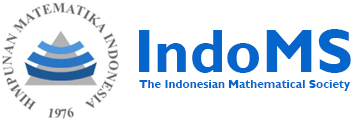EFEKTIVITAS MODEL PENEMUAN TERBIMBING DENGAN MENGGUNAKAN TUGAS SUPERITEM TERHADAP KEMAMPUAN PEMECAHAN MASALAH MATEMATIKA MAHASISWA
 PDF Download: 607
PDF Download: 607
DOI:
https://doi.org/10.32665/james.v1iOctober.32Keywords:
guided discovery, superitem, solution to problem, penemuan terbimbing, pemecahan masalahAbstract
References
[1] Bigg, J. B. dan Collis, Evaluating The Quality of Learning : The Solo Taxonomy, New York : Akademik Press Inc. (1982)
[2] Budiyono, Metode Penelitian Pendidikan, Surakarta: UNS Press. (2003).
[3] Maesaroh, S., Meningkatkan Kemampuan Penalaran Matematis Siswa SMA Melalui Pembelajaran Penemuan Terbimbing dengan Menggunakan Tugas Bentuk Superitem, Bandung: UPI (tidak diterbitkan). (2007).
[4] Markaban. Model Penemuan Terbimbing Pada Pembelajaran Matematika SMK. Yogyakarta : Pusat Pengembangan dan Pemberdayaan Pendidik dan Tenaga Kependidikan Matematika. (2006).
[2] Budiyono, Metode Penelitian Pendidikan, Surakarta: UNS Press. (2003).
[3] Maesaroh, S., Meningkatkan Kemampuan Penalaran Matematis Siswa SMA Melalui Pembelajaran Penemuan Terbimbing dengan Menggunakan Tugas Bentuk Superitem, Bandung: UPI (tidak diterbitkan). (2007).
[4] Markaban. Model Penemuan Terbimbing Pada Pembelajaran Matematika SMK. Yogyakarta : Pusat Pengembangan dan Pemberdayaan Pendidik dan Tenaga Kependidikan Matematika. (2006).
Downloads
Published
2018-10-25
Issue
Section
Articles
License
Authors who publish with this journal agree to the following terms:
- Authors retain copyright and grant the journal right of first publication with the work simultaneously licensed under a Creative Commons Attribution License that allows others to share the work with an acknowledgment of the work's authorship and initial publication in this journal.
- Authors are able to enter into separate, additional contractual arrangements for the non-exclusive distribution of the journal's published version of the work (e.g., post it to an institutional repository or publish it in a book), with an acknowledgment of its initial publication in this journal.
- Authors are permitted and encouraged to post their work online (e.g., in institutional repositories or on their website) before and during the submission process, as it can lead to productive exchanges, as well as earlier and greater citation of published work
 PDF Download: 607
PDF Download: 607















